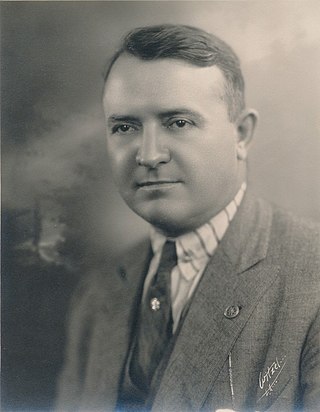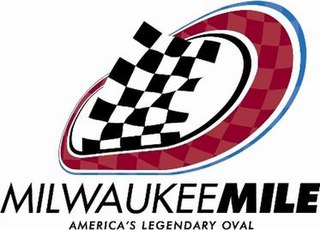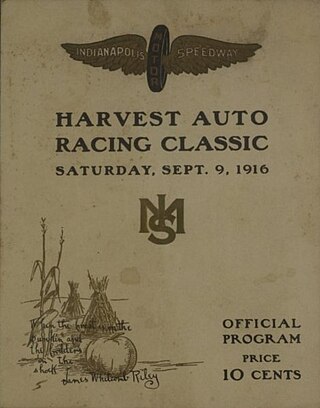
Ray Wade Harroun was an American racing driver and pioneering race car constructor. He is most famous for winning the inaugural Indianapolis 500 in 1911.

Berna Eli "Barney" Oldfield was a pioneer American racing driver. His name was "synonymous with speed in the first two decades of the 20th century". He was the winner of the inaugural AAA National Championship in 1905.

American open-wheel car racing, generally known as Indy car racing, or more formally Indianapolis car racing, is a category of professional automobile racing in the United States. As of 2024, the top-level American open-wheel racing championship is sanctioned by IndyCar. Competitive events for professional-level, open-wheel race cars have been conducted under the auspices of various sanctioning bodies, tracing its roots as far back as 1902. A season-long, points-based, National Championship of drivers has been officially recognized in 1905, 1916, and each year since 1920. As such, for many years, the category of racing was known as Championship car racing. That name has fallen from use, and the term Indy car racing has become the preferred moniker.

The Milwaukee Mile is a 1.015 mi (1.633 km) oval race track in the central United States, located on the grounds of the Wisconsin State Fair Park in West Allis, Wisconsin, a suburb west of Milwaukee. Its grandstand and bleachers seats approximately 37,000 spectators. Paved 70 years ago in 1954, it was originally a dirt track. In addition to the oval, there is a 1.8 mi (2.9 km) road circuit located on the infield.

The Peak Antifreeze and Motor Oil Indy 300 was an IndyCar Series race held at Chicagoland Speedway in Joliet, Illinois, United States.
The 1915 Grand Prix season saw Grand Prix motor racing continue in the United States. Racing was suspended in Europe due to the outbreak of World War I. The American Grand Prize was held in San Francisco for the first time, in conjunction with the Panama–Pacific International Exposition. Several of the latest European cars had been imported to the USA before the war started. Briton Dario Resta had a Peugeot and Ralph DePalma raced one of the Mercedes GPs. While Resta won both races at San Francisco and DePalma won the Indianapolis 500, just ahead of Resta it was Earl Cooper, running a Stutz, whose consistency gave him the unofficial AAA national championship.
The 1916 Grand Prix season saw Grand Prix motor racing continue in the United States. Racing was suspended in Europe due to the World War I engulfing the continent. Once again European cars dominated Indianapolis with victory going to Briton Dario Resta in a Peugeot. With the organisers wanting to appeal to the spectators, this was the only year that the race was scheduled for a shorter length – to run only 300 miles. The Vanderbilt Cup and the American Grand Prize returned to Santa Monica, California, at the end of the year. Resta repeated his victory from the year before, winning the Vanderbilt Cup. Then when he retired in the Grand Prize it was Howdy Wilcox and Johnny Aitken who won in another of the dominant Peugeots. Oval courses now dominated the AAA Championship with these two events being the only road-course races this year. It proved to be the final time these two formative American races were held in this format; while racing in America continued throughout the First World War, public interest had shifted away from road racing.

Tom Cooper was an American cyclist and early automobile racing driver. He is best known for his rivalry with cyclist Major Taylor, as well as his later work with Henry Ford and Barney Oldfield.

The Harvest Auto Racing Classic was a series of three automobile races held at the Indianapolis Motor Speedway on Saturday September 9, 1916. The meet, held four months after the 1916 Indianapolis 500, featured a 20-mile race, a 50-mile race, and a 100-mile race. The main event, a 100-mile Championship Car race, paid points towards the 1916 AAA National Championship. Johnny Aitken won all three races, two of which had a margin of victory of less than a car length.
The 1938 AAA Championship Car season consisted of two races, beginning in Speedway, Indiana on May 30 and concluding in Syracuse, New York on September 10. There were also two non-championship events. The AAA National Champion and Indianapolis 500 winner was Floyd Roberts.
The 1909 AAA Championship Car season consisted of 24 races, beginning in Portland, Oregon on June 12 and concluding with a point-to-point race from Los Angeles, California to Phoenix, Arizona on November 6. There were three events sanctioned by the Automobile Club of America in Lowell, Massachusetts. AAA did not award points towards a National Championship during the 1909 season, and did not declare a National Champion.
The 1910 AAA Championship Car season consisted of 19 races, beginning in Atlanta, Georgia on May 5 and concluding in Long Island, New York on October 1. AAA did not award points towards a National Championship during the 1910 season, and did not declare a National Champion.
The AAA Contest Board was the motorsports arm of the American Automobile Association. The contest board sanctioned automobile races from 1904 until 1955, establishing American Championship car racing. Modern-day Indy car racing traces its roots directly to these AAA events.
The 1920 AAA Championship Car season consisted of 5 races, beginning in Beverly Hills, California on February 28 and concluding in Beverly Hills on November 25. The AAA National Champion and Indianapolis 500 champion was Gaston Chevrolet. The 1920 season later became a source of confusion and misinformation for historians when in 1926 the AAA published a revisionist history, naming another driver as the season's point champion.
The 1946 AAA Championship Car season was the first season of American Championship car racing following World War II. After four years without automobile racing in the United States, the AAA Contest Board was initially concerned about having enough races, enough entrants, and suitable equipment, to contest season on such short notice for 1946. Even the Indianapolis 500 was in doubt, as the Indianapolis Motor Speedway had been fallen into a terrible state of neglect during the war years.
The IndyCar Rookie of the Year Award is presented to the first-year driver that has the best season in a IndyCar Series season.
The 1912 AAA Championship Car season consisted of 18 races, beginning in Santa Monica, California on May 4 and concluding in Brooklyn, New York on November 5. There was also one non-championship event at Milwaukee, Wisconsin. AAA did not award points towards a National Championship during the 1912 season, and did not declare a National Champion. Joe Dawson was the winner of the Indianapolis 500.






